And here, you confuse homologous structures with analogous structures. Our forelimbs are very unlike the forelimbs of a horse. They are homologous; the same bones are in each of our limbs, although greatly modified to different purposes.
...they are structurally very different. In many different ways. But they are derived from the same genes, the same embryonic tissues, under control of the same homeobox genes. They are homologous.
So they are similar genetic expressions driving the organization of similar tissues, like I said.
Human and Octopus eyes are structurally very similar and even driven by similar genetic expression. According to your criteria, the human and octopus eyes are most certainly homologous. Oops, but that doesn’t make sense because those Vertebrae and Mollusca would have diverged from each other long before each group developed such an advanced organ… so they couldn’t have derived their eyes from a common ancestor.
Not to worry, in this case evolutionists will infer that the highly similar eye structures evolved independently while recruiting the shared genetic toolkit from their ancient ancestors, a case of “deep homology”...
However, if the Human and Octopus phylogenies happened to be placed more closely together, then the same exact data would be used as proof of homology of the organ as a whole.
The crux of Evolution is what version of its story seems most palatable. For all evolutionists know (and some quietly admit this in the literature) … similar genetic/anatomic expressions could have evolved independently to much higher degree than is currently understood.
“The principle of homology is central to conceptualizing the comparative aspects of morphological evolution. The distinctions between homologous or non-homologous structures have become blurred, however, as modern evolutionary developmental biology (evo-devo) has shown that novel features often result from modification of pre-existing developmental modules, rather than arising completely de novo. “
Deep homology in the age of next-generation sequencing - PubMed (nih.gov)
However since the whole point of phylogenetics is to organize phylogenies and tell a story of Evolution, evolutionists usually prefer to describe things as being shared and derived from common ancestors, and defer to independent convergence only when necessary.
It’s all just clever storytelling.
Torture data long enough and you can get it to tell you any story you want.
The wings of pterosaurs and wings of bats are analogous; they are very similar, but are derived from different tissues.
I see, so they are dissimilar tissue structures, and thus have dissimilar genetic expressions, like I said. Is this too simple of an explanation? Not loaded with enough unnecessary Evolution-jargon for your taste?
"Homologous" and "analogous" are well-defined and testable.
This isn’t really true at all. Character traits once identified as homologous are routinely redefined as homoplasy (convergently or independently evolved )
Such traits are identified on the basis of what is ‘most likely’ to be the case, or what seems the most likely explanation without upsetting too much of the overall picture of evolutionary history.
Look at the Human and Octopus eye example again… similar phenotypic organization and genetic expression pathways. This would characteristically result in a strong signal of homology. But since that story would throw the entire evolutionary tree into disarray, its homology status is arbitrarily stripped away... its elements are split off into homologous and homoplasious identities as needed to rescue the generally accepted story of evolution.
All proceeding under the assumption that Evolution must be true, which itself is never questioned…. Nor can it be, in principle, when you have boxed yourself into methodological naturalism as the only way to interpret reality, and thus to these institutions, the answer must always be Evolution and only Evolution.
In my experience, Evolutionists are overly confident either out of ignorance or because of a religious zeal to promote the theory, usually a combination of both.
The Evolution story just isn't true. It was written by men for the pride of men. The God of Israel has plainly revealed to us why billions of animals were buried all over the earth. We don't want to see it because it reminds us of the world Judgment before and the world Judgment to come. As the Lord and God, the King of Kings spoke himself: "The Days of Noah" which are coming upon us again at the end. - Matthew 24:37
Jesus is Lord and Savior.


